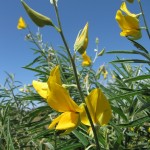USDA researchers say the tropical legume sunn hemp (Crotalaria juncea) is a fast-growing annual that farmers in the Southeast could incorporate into their crop rotations and it could be used as a biofuel source.

A study, conducted by Agricultural Research Service (ARS) scientists in Florence, S.C., supports the USDA priority of finding new sources of bioenergy. Results from the study were published in 2010 in Biomass and Bioenergy.
ARS agricultural engineer Keri Cantrell, agronomist Philip Bauer, and environmental engineer Kyoung Ro all work at the ARS Coastal Plains Soil, Water, and Plant Research Center in Florence. They compared the energy content of sunn hemp with cowpea (Vigna unguiculata), another common regional summer cover crop, in 2004 and 2006.
Both crops were grown in experimental plots near Florence and were harvested on the same day three times in each study year. The last harvest for both years was conducted right after the first killing freeze of the season. The scientists measured potential energy production of both feedstocks via direct combustion. This provided the feedstocks’ higher heating value (HHV), which indicates how much energy is released via combustion.

In 2004, when there was ample rainfall, the resulting sunn hemp biomass yield totaled more than 4.5 tons per acre. This is equivalent to 82.4 gigajoules of energy per acre, close to the energy contained in 620 gallons of gasoline and well in the ballpark of other bioenergy crops, which have yields of anywhere from 30 to 150 gigajoules per acre.
The HHV for sunn hemp biomass exceeded the HHV for switchgrass, bermudagrass, reed canarygrass and alfalfa. Although reduced rainfall resulted in lower hemp biomass yields in 2006, sunn hemp’s HHV for both study years was 4 to 5 percent greater than the HHV of cowpeas.
Read more about this research in the January 2012 issue of Agricultural Research magazine.

